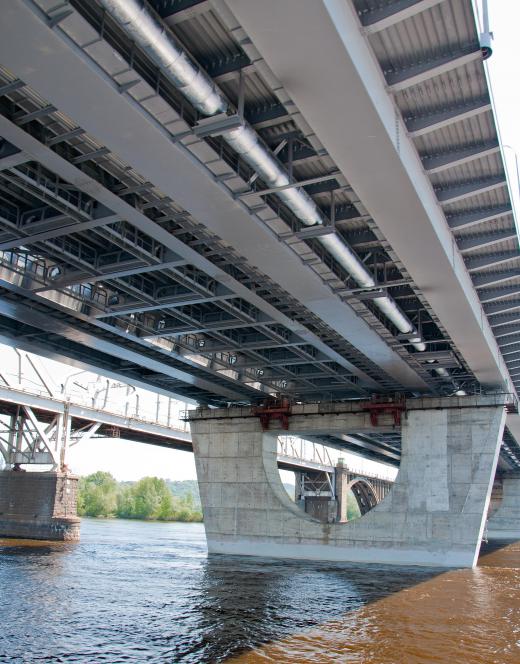What is Beam Bending?
In civil engineering, beam bending refers to the behavior of certain structural elements in a physical design. An element can be considered a beam if it is solid and homogenous and its length is many times its height or width. The primarily function of the beam is to resist bending; this stands in contrast to structural elements that primarily resist tension, compression or shear stresses. The structural properties of a beam in bending are determined by its dimensions, materials and cross-sectional shape.
A simple example of beam bending is a bridge with a car on it. Bridges often have concrete roads on top of them, but concrete is generally only strong in compression. A long bridge, however, will tend to sag in the middle where there is no ground to support it. This sagging will be in the shape of a circular arc and occurs because of the way internal stresses are distributed in beam bending. To resist this bending, a stronger metal beam is usually placed under a road surface.

The most important equation in beam bending is the Euler-Bernoulli beam equation. This equation relates the deflection of the beam to applied forces, cross section characteristics and material properties of the beam. The amount of deflection in beam bending can be reduced by reducing net applied forces, reshaping the beam’s cross section and using a stronger material.

In a horizontal beam with downward forces applied to it, the upper part of the beam will actually go into compression while the lower part will go into tension. In fact, the further down material is, the more tension it will experience. It turns out that, for a given amount of total material, reinforcing the bottom and top regions of the cross section is the best way to make the beam stronger. Therefore, engineers design beams with material concentrated toward the bottom and top regions of the cross section.
This is the principle behind the design of I-beams, or beams with cross sections that resemble the letter "I." It is expensive to produce and transport beams with lots of mass, so it is important to minimize the amount of material used. In the cross section of an I-beam, there is only enough material at intermediate heights to keep the beam together as a solid piece. The rest of the material is concentrated at the bottom and top of the cross section, giving the beam a high resistance to bending. A beam’s resistance to bending is called its stiffness.
AS FEATURED ON:
AS FEATURED ON:












Discuss this Article
Post your comments